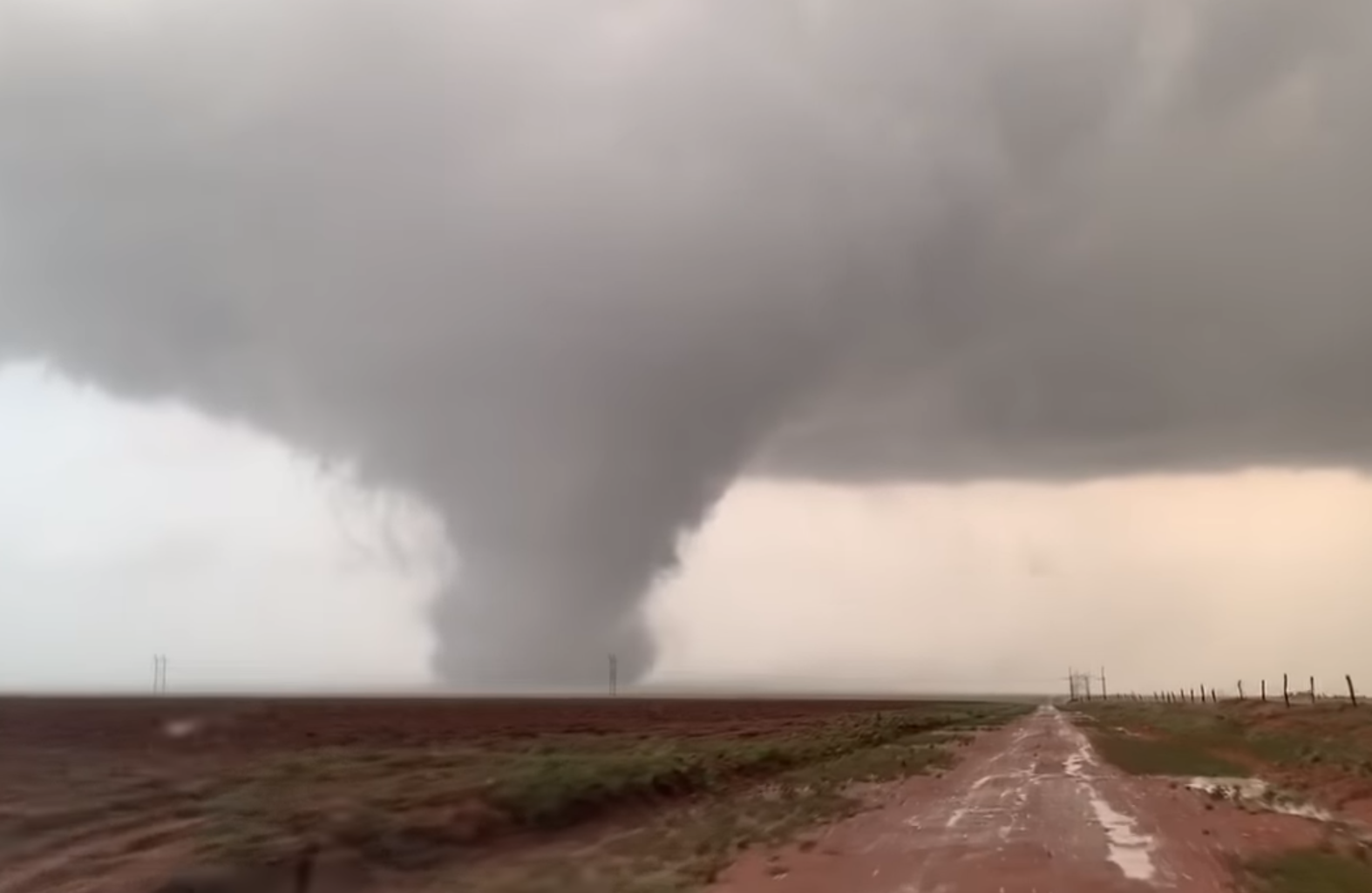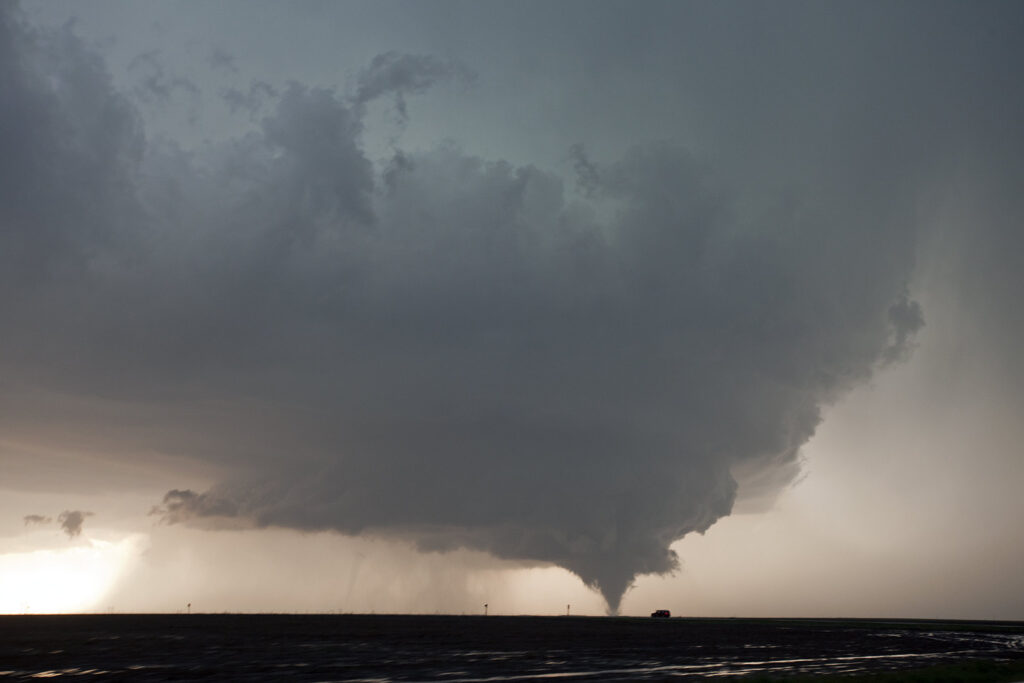
Tornado events come in all shapes and sizes. At smaller scale, they can impact just about anywhere given the right ingredients, but in the United States they mostly happen east of the Rockies.
The country sees about a handful of sizable tornado outbreaks a year. During the peak months of April, May and June, they migrate out of the Deep South to the north and west toward the international border by the end of the three-month stretch.
April violence to May and June regularity
This month opened with a major tornado outbreak and has been sprinkled with additional regional outbreaks since. It might end with another hefty count of new twisters, likely pushing an already above average April 2025 into the top-tier for monthly twisters following a similarly intense March.
The month currently averages 190 tornadoes, with 269 in May and 191 in June. Those are typically the big tornado months of the year, although they can and do happen plenty of other times.
Annual and monthly tornado averages by state
Early in the season, established moisture is harder to come by and most frequently gathered nearby the Gulf of Mexico. As warmth expands northward, and the jet stream tags along with it, severe weather and tornado risk also shifts northward. By midsummer, Canada is often the hotspot.
April outbreaks tend to be less common but more violent. May outbreaks love Oklahoma and are basically an annual occurrence there into Kansas and surrounding areas. By June, the risk heavily focuses on the north-central states.
Outbreak central
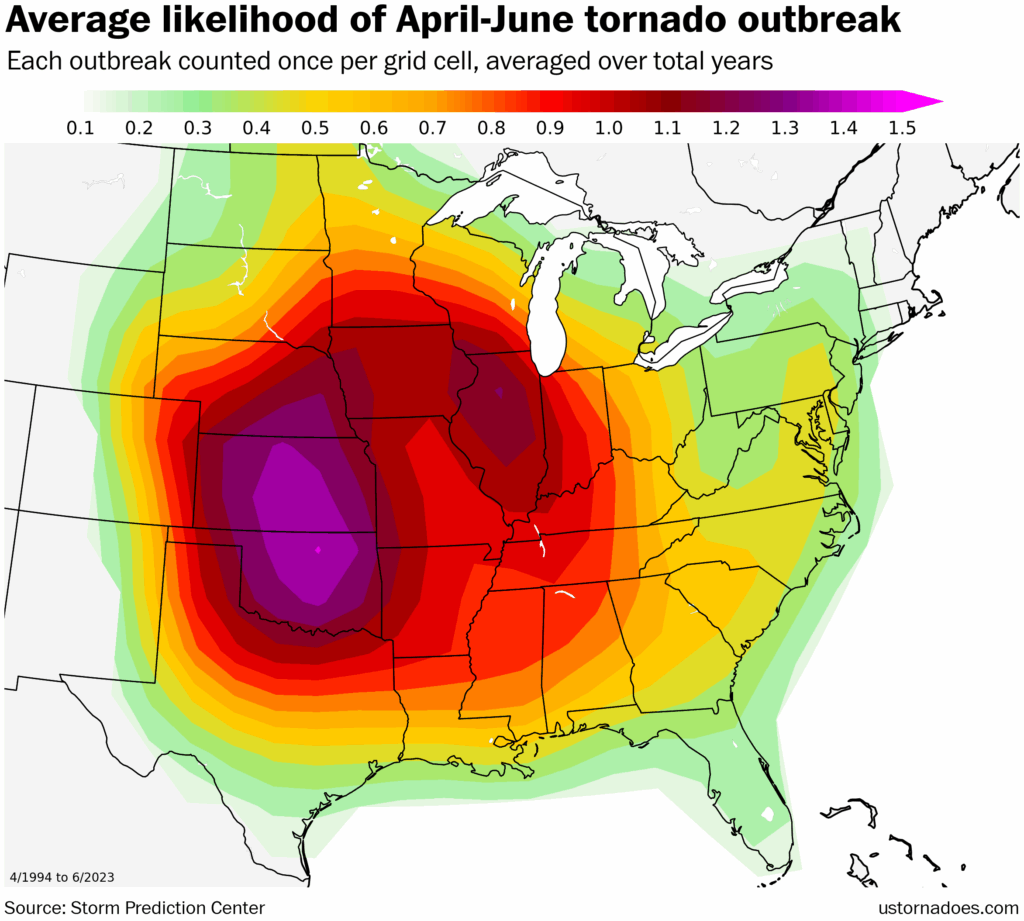
There probably aren’t many surprises looking at a heatmap of annual outbreak likelihood during the April-June period.
Based on this analysis, an area around Pawnee to Ponca City in Oklahoma has the highest risk of an annual tornado outbreak during peak season. Figures are based on the most recent 30 years of data in the SPC database, which represents a more recent climate than the entire modern record dating to 1950.
While there has been much discussion about a shift in where tornado activity occurs, the classic tornado alley is still well represented. Most of Oklahoma, all of Kansas, all of Iowa, most of Illinois, Nebraska and chunks of surrounding states could expect to be threatened by at least one nearby tornado outbreak a year.
The South and Midwest are also frequent outbreak locations, happening at least about every other year or more often. Interestingly for the author, the D.C. area is on a bit of an elevated nose across lower elevations to the east of the Appalachians. In this region, warm, moist air can surge northward with greater ease as low pressure passes.
Big ones in peak season
The king, April 2011, will forever be hard to top. In some ways, other outbreaks — like the other huge April one in 1974 — outdo that event. In shear scope, 2011 is still hard to fathom.
Every month from April to June has seen outbreaks around or above 100 twisters. In April and May’s cases the top events are way above that mark.
(Please note the SPC database does not yet include 2024, so it is not part of this analysis).
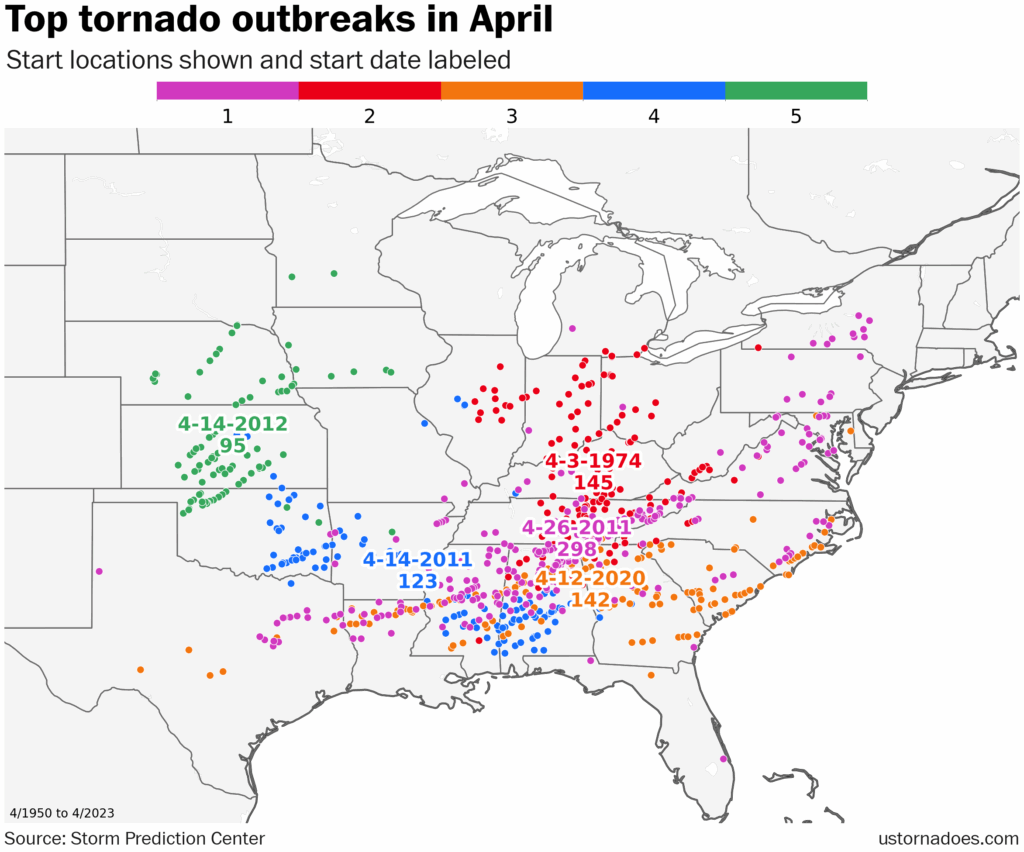
April doesn’t play by the rules. The month can be somewhat timid when winter’s chill holds tough, then there’s 2011 which featured two of the top five tornado outbreaks for the month on record. We all know the big one — the Super Outbreak from April 26-28 that dropped about 300 tornadoes including four EF5 and 11 EF4.
| Start | End | Tornadoes | F/EF2+ | F/EF4+ | Killer | Deaths | Max F/EF | Top state |
|---|---|---|---|---|---|---|---|---|
| 4/26/2011 | 4/28/2011 | 298 | 78 | 15 | 29 | 319 | 5 | TN |
| 4/3/1974 | 4/4/1974 | 145 | 97 | 30 | 48 | 310 | 5 | TN |
| 4/12/2020 | 4/13/2020 | 142 | 35 | 3 | 8 | 30 | 4 | GA |
| 4/14/2011 | 4/16/2011 | 123 | 29 | 0 | 5 | 12 | 3 | AL |
| 4/14/2012 | 4/15/2012 | 95 | 9 | 1 | 1 | 6 | 4 | KS |
| 4/9/2009 | 4/11/2009 | 87 | 21 | 1 | 2 | 5 | 4 | GA |
| 4/19/1996 | 4/20/1996 | 81 | 22 | 0 | 1 | 1 | 3 | IL |
| 4/19/2011 | 4/20/2011 | 80 | 10 | 0 | 0 | 0 | 3 | IN |
| 4/10/2001 | 4/11/2001 | 79 | 12 | 0 | 3 | 4 | 3 | IA |
| 4/27/2014 | 4/29/2014 | 77 | 28 | 2 | 7 | 34 | 4 | AL |
| 4/13/2019 | 4/15/2019 | 74 | 18 | 0 | 2 | 3 | 3 | MS |
| 4/4/2022 | 4/5/2022 | 74 | 14 | 1 | 1 | 1 | 4 | GA |
| 4/26/1994 | 4/27/1994 | 68 | 10 | 1 | 1 | 3 | 4 | TX |
| 4/2/2006 | 4/2/2006 | 67 | 14 | 0 | 5 | 27 | 3 | IL |
| 4/2/1982 | 4/3/1982 | 61 | 29 | 4 | 10 | 30 | 5 | AR |
| 4/15/1998 | 4/16/1998 | 61 | 21 | 2 | 7 | 12 | 5 | IL |
| 4/29/2017 | 4/30/2017 | 61 | 9 | 1 | 3 | 5 | 4 | MS |
| 4/10/1979 | 4/12/1979 | 60 | 31 | 2 | 5 | 58 | 4 | TX |
| 4/7/1980 | 4/9/1980 | 60 | 30 | 0 | 2 | 3 | 3 | AR |
| 4/26/1991 | 4/27/1991 | 56 | 30 | 5 | 5 | 21 | 5 | KS |
| 4/7/2006 | 4/8/2006 | 56 | 6 | 0 | 3 | 10 | 3 | AL |
| 4/30/2019 | 4/30/2019 | 56 | 4 | 0 | 1 | 2 | 3 | MO |
| 4/8/1999 | 4/9/1999 | 55 | 16 | 3 | 3 | 6 | 4 | IA |
| 4/16/2011 | 4/16/2011 | 55 | 16 | 0 | 6 | 26 | 3 | NC |
| 4/13/2018 | 4/14/2018 | 55 | 8 | 0 | 1 | 1 | 2 | LA |
In between those events on the top five, we have the Super Outbreak of 1974. Prior to 2011, it was the gold medal modern outbreak, and by number of violent tornadoes it still outdoes 2011 by a good deal.
A year later, in 2012, a massive outbreak struck a place more typical of May with twisters marching across Oklahoma, Kansas and Nebraska.
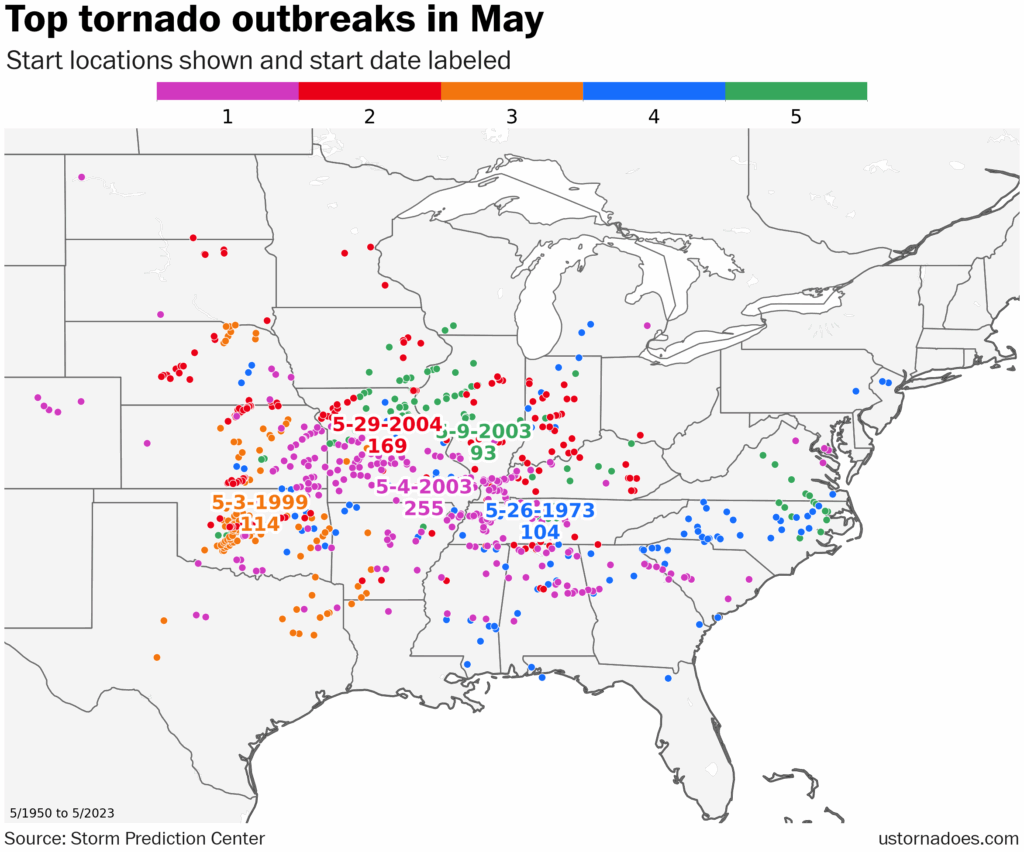
Perhaps the most well-known May outbreak is the 3rd largest in the month. And it’s May 3rd, 1999. With tornadoes swarming the Oklahoma City area — including an F5 in Moore — this one will forever be etched in the minds of tornado watchers.
| Start | End | Tornadoes | F/EF2+ | F/EF4+ | Killer | Deaths | Max F/EF | Top state |
|---|---|---|---|---|---|---|---|---|
| 5/4/2003 | 5/8/2003 | 255 | 44 | 6 | 8 | 40 | 4 | MO |
| 5/29/2004 | 5/31/2004 | 169 | 17 | 1 | 3 | 5 | 4 | KS |
| 5/3/1999 | 5/4/1999 | 114 | 28 | 4 | 6 | 47 | 5 | OK |
| 5/26/1973 | 5/29/1973 | 104 | 44 | 3 | 8 | 22 | 4 | NC |
| 5/9/2003 | 5/11/2003 | 93 | 18 | 0 | 1 | 1 | 3 | IL |
| 5/25/2011 | 5/26/2011 | 93 | 14 | 0 | 0 | 0 | 3 | IN |
| 5/5/2007 | 5/6/2007 | 91 | 17 | 0 | 1 | 1 | 3 | KS |
| 5/18/1995 | 5/19/1995 | 80 | 21 | 2 | 2 | 4 | 4 | TN |
| 5/10/2008 | 5/11/2008 | 79 | 20 | 2 | 3 | 24 | 4 | GA |
| 5/23/2008 | 5/23/2008 | 79 | 16 | 1 | 1 | 2 | 4 | KS |
| 5/11/1982 | 5/12/1982 | 70 | 15 | 0 | 1 | 2 | 3 | TX |
| 5/10/2010 | 5/10/2010 | 70 | 14 | 2 | 2 | 3 | 4 | OK |
| 5/3/2021 | 5/4/2021 | 70 | 5 | 0 | 0 | 0 | 2 | TN |
| 5/22/2004 | 5/22/2004 | 65 | 4 | 1 | 1 | 1 | 4 | NE |
| 5/2/1984 | 5/3/1984 | 62 | 15 | 0 | 1 | 5 | 3 | AL |
| 5/27/2019 | 5/28/2019 | 62 | 11 | 1 | 1 | 1 | 4 | OH |
| 5/1/2008 | 5/2/2008 | 61 | 13 | 0 | 2 | 6 | 3 | AR |
| 5/16/2015 | 5/17/2015 | 59 | 4 | 0 | 0 | 0 | 3 | OK |
| 5/18/2017 | 5/19/2017 | 58 | 3 | 0 | 0 | 0 | 2 | OK |
| 5/8/1988 | 5/8/1988 | 57 | 15 | 0 | 0 | 0 | 3 | WI |
| 5/25/1997 | 5/25/1997 | 53 | 3 | 0 | 0 | 0 | 2 | KS |
| 5/24/2004 | 5/24/2004 | 53 | 2 | 0 | 1 | 1 | 2 | KS |
| 5/25/1965 | 5/27/1965 | 52 | 16 | 0 | 0 | 0 | 3 | KS |
| 5/20/2019 | 5/21/2019 | 52 | 5 | 0 | 0 | 0 | 3 | OK |
| 5/15/2003 | 5/16/2003 | 49 | 7 | 0 | 0 | 0 | 2 | TX |
Although Missouri is often thought of as a “lull” in a very active belt for tornado activity, with more numbers west and east, we see it is near the heart of May tornado outbreaks of note. And May 22, 2011 isn’t on the list. That was the day Joplin was hit by an EF5 in an outbreak featuring dozens of tornadoes.
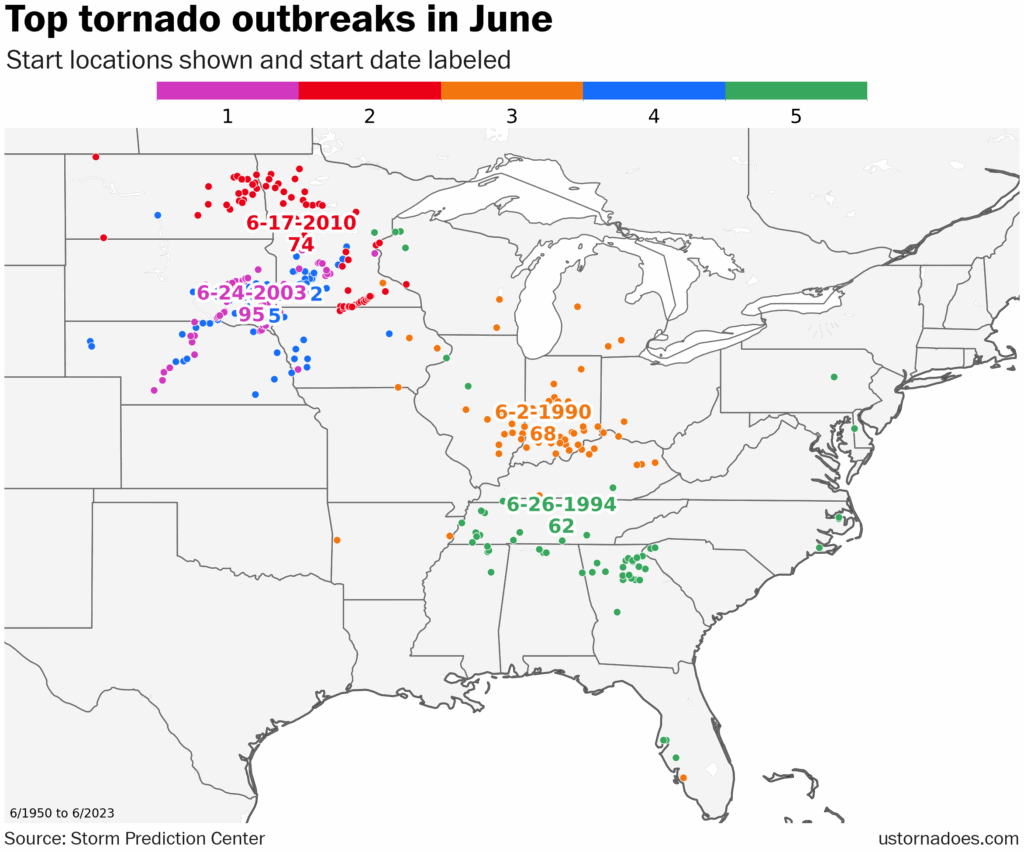
If you’re looking for a big June outbreak, you’re probably hanging out in the northern Plains to upper Midwest. It’s been a while, but two of the top 5 June outbreaks also occurred in a zone from the Mid-Mississippi River Valley to Ohio in the north and Georgia in the South.
| Start | End | Tornadoes | F/EF2+ | F/EF4+ | Killer | Deaths | Max F/EF | Top state |
|---|---|---|---|---|---|---|---|---|
| 6/24/2003 | 6/24/2003 | 95 | 10 | 1 | 0 | 0 | 4 | SD |
| 6/17/2010 | 6/17/2010 | 74 | 15 | 4 | 3 | 3 | 4 | MN |
| 6/2/1990 | 6/2/1990 | 68 | 29 | 7 | 4 | 9 | 4 | IN |
| 6/16/1992 | 6/16/1992 | 65 | 34 | 2 | 1 | 1 | 5 | MN |
| 6/26/1994 | 6/27/1994 | 62 | 9 | 0 | 2 | 2 | 3 | GA |
| 6/15/1992 | 6/16/1992 | 58 | 16 | 2 | 0 | 0 | 4 | KS |
| 6/8/1993 | 6/8/1993 | 58 | 3 | 0 | 0 | 0 | 3 | WI |
| 6/3/2008 | 6/4/2008 | 57 | 2 | 0 | 1 | 1 | 3 | NE |
| 6/20/1981 | 6/21/1981 | 46 | 5 | 0 | 2 | 2 | 3 | IL |
| 6/5/2010 | 6/6/2010 | 46 | 14 | 1 | 2 | 8 | 4 | IL |
| 6/7/1984 | 6/8/1984 | 45 | 29 | 2 | 3 | 13 | 5 | IA |
| 6/13/1998 | 6/13/1998 | 45 | 3 | 0 | 0 | 0 | 2 | KS |
| 6/15/2023 | 6/16/2023 | 45 | 7 | 0 | 1 | 3 | 3 | OH |
| 6/21/2023 | 6/21/2023 | 45 | 4 | 0 | 1 | 4 | 3 | CO |
| 6/4/1999 | 6/4/1999 | 44 | 4 | 0 | 1 | 1 | 2 | IL |
| 6/30/2014 | 6/30/2014 | 42 | 1 | 0 | 0 | 0 | 2 | IN |
| 6/4/1955 | 6/5/1955 | 41 | 6 | 2 | 0 | 0 | 4 | KS |
| 6/7/1993 | 6/7/1993 | 40 | 14 | 2 | 0 | 0 | 4 | SD |
| 6/29/1998 | 6/30/1998 | 40 | 2 | 0 | 0 | 0 | 2 | IL |
| 6/13/2001 | 6/13/2001 | 40 | 4 | 1 | 0 | 0 | 4 | MN |
| 6/4/2005 | 6/4/2005 | 40 | 1 | 0 | 0 | 0 | 2 | WI |
| 6/5/2008 | 6/5/2008 | 40 | 3 | 0 | 0 | 0 | 2 | KS |
| 6/11/2008 | 6/11/2008 | 40 | 7 | 1 | 3 | 6 | 4 | IA |
| 6/28/1979 | 6/28/1979 | 38 | 6 | 1 | 2 | 5 | 4 | MN |
| 6/11/2004 | 6/11/2004 | 38 | 4 | 0 | 0 | 0 | 3 | IA |
Part of a barrage of tornadoes in the region during the season, the June 17, 2010 event was particularly impressive for its violence. Four EF4 tornadoes struck Minnesota and North Dakota that day as twisters raged across the two states.
Any change over time?
Much great scholarship on shifts in tornadoes has been done in recent years. I certainly do not have anything groundbreaking to offer there. However, this analysis did highlight several things that fit into those ideas.
- The largest area of significant increase in seasonal odds of a tornado outbreak are across the mid-South, then in an axis to the northwest through parts of Missouri, Arkansas, Oklahoma and Kansas. How much is related to tornado inflation, over the years with more spotters, is outside my scope.
- West Texas is a center of the largest and deepest decrease in outbreaks over the past 50 years. Similar is seen centered on Michigan.
- Florida and the northern Plains have also exhibited fewer outbreaks, although these regions might also relatively regularly see them into July.
Methodology
I kept it pretty simple, although the definition of a tornado outbreak is anything but. Basically, once 12 tornadoes have occurred, if there’s no gap greater than 6 hours, it’s an outbreak and it stays one until that rule is broken.
The starting number is perhaps up for debate, as is the break time, but in peak season and to capture the most notable events in our current climate, this works just fine.
Because it is a relatively simple and algorithmic build, there may be small differences than other analyses at the edges, especially with tornado barrages like that of May 2003, which went on and on, then on some more. Where one event ends and another begins can be tricky. If you have any thoughts, I’d love to hear them!
Latest posts by Ian Livingston (see all)
- Tornado outbreaks: April, May and June peak-season primer - April 27, 2025
- Busy March for twisters to end with another multi-day event - March 28, 2025
- Everything but locusts: NWS shines in apocalyptic weather - March 17, 2025
